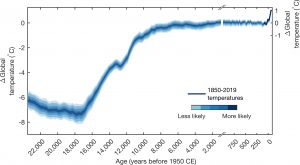New Method Reveals the Unparalleled Extent of Today’s Global Warming
Researchers at the University of Arizona have recreated the last 24,000 years of Earth’s climate, dating back to the last ice age, using a method developed by co-author Gregory Hakim, professor in UW’s Atmospheric Sciences Department.
Hakim’s strategy is a form of data assimilation and involves combining the strengths of both observational data from paleoclimate proxies and computer models of climate to best reconstruct past temperatures. Although proxies are the most complete data source currently available to us, they are not infallible, containing gaps and uncertainties in both space and time. In contrast, computer models can create detailed simulations of climate based on the laws of physics but lack an observational record to complement their predictions. Therefore, in combining these resources, the most complete picture of past climate can be constructed, which is exactly what University of Arizona researchers Matthew Osman and Jessica Tierney have done with Hakim’s help.
Using this method, the researchers have found that 1) in the 24,000 years since the last ice age, the main drivers of climate change have indeed been rising greenhouse gas concentrations and the retreat of ice sheets, 2) in the last 10,000 years, there has been a general trend of warming, clarifying a subject of debate among the paleoclimate community, and 3) in the last 150 years, the magnitude and rate of warming are unprecedented compared to any other time during the last 24,000 years.

The method of data assimilation, now that it has been verified to accurately display paleoclimate, will be invaluable to future research. Already, researchers are applying this method to even more ancient climates, especially among periods of warming, to help provide a potential model of how our own age of warming may turn out.